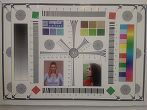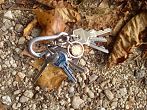Samsung D600 camera review: A place at the top
A lot of settings
After having gone through all lengthy "details" we have finally come to the point of our review. Let us now pay special attention to sample photos. Let me start right away with one of those pictures, I took in piles during the testing process - a photo of my pointing finger. The lens is mounted somewhat inconveniently.
Note: the sample photos have been resampled to 800 × 600 pixels for faster downloads. The more important sample photos are shown in full size. In such case the link takes you to a file of up to 400 KB.

There is no doubt that in the beginning you will take plenty of faulty pictures, just like the one above
One of the factors that play especially important role for the quality of a certain picture is its image sharpness. Here Samsung seems to suffer certain difficulties, caused by its fixed focus. The sample pattern taken from about 1.5 meters reveals this weak spot quite clearly. Even though the phone takes good pictures from far distance, it is practically useless for macro photography.
Note: the strong noise in the testing pattern photo is caused by the low lighting.



Sharp image photos from greater distance only
The difficulty that the Samsung D600E has with focusing at shorter distance may turn to be quite unpleasant if you decide to scan texts. It is better to shoot from a distance, for the text will be easy to read considering the high resolution of the sensor.


It is better to scan text from a distance
The zooming-in process is nothing special, but it is applicable in practice. Pictures are captured in full size, which causes a certain downgrade in its quality, but it is still possible to look at. Besides, when I think of the useless 20x digital zoom of Nokia N90, the solution offered by Samsung seems to me much clever.
Now I would like to pay more attention to the proper exposure settings. Samsung D600's camera surprised me with its accurate automatic exposure. I guess most of you will come to use exposure compensation rarely. What disappointed me was the exposure compensation implementation - it feels like nothing but a software manipulation additionally applied to the taken image.



Picture taken with automatic exposure • +2 exposure compensation • -2 exposure compensation
As for the high contrast scenes, the phone managed them quite fairly. And once again, I tried to help it by using the exposure compensation option in order that the light sky did not have such a strong impact on the final picture. It worked out - the second picture looks somewhat better than the first one. The last picture is for a demonstration only.




Automatic exposure • -1 exposure compensation • -2 exposure compensation • +1 exposure compensation
As you can expect, I also tested the metering options, which were best applicable in a dark passage. I used evaluative metering in the first picture and spot metering in the second one, where the passage details are well visible, but the environment is overexposed. This function can be sometimes quite practical indeed. In spot metering only the middle part of the picture is taken into account.


Evaluative... • ... and spot metering
As the automatic settings worked well, I did not make any big use of the manual white balance. Various settings are displayed in the pictures below. Even though the weather was cloudy (manually setup cloudy mode is used in the second picture), the first picture, where balancing is set automatically, reflects reality the best.




White balance: automatic • cloudy • sunny • fluorescent
Automatics met my expectations for the ISO sensitivity as well. Higher sensitivity is used when necessary only - to keep the shutter speed high enough in low light. It's interesting to note that some digital cameras show more noise at ISO 400, than what we see in our Samsung D600 ISO 400 sample.



ISO sensitivity at 100 • at 200 • at 400
You may find the flash diode useful, especially when the light is low. Unfortunately, it is quite weak and seems to be practically helpful only for pictures taken from no more than a meter.


Shooting with flash at a distance of approximately 75 cm • flash at a 2 meters distance is useless
Later I put a teddy bear in a dark corridor, leaving a strike of light to fall over it through the transparent glass of a door. The first picture was taken in automatic mode; the second one was made in night mode. As both pictures do not differ almost at all, my logical conclusion is that the night mode is nothing but an increase of the ISO sensitivity to maximum. The last picture is taken once again with a flash and activated night mode.



It is useless to fuss about the setup of the night mode
Samsung D600 surprised me with its color effects menu. Beside the standard black& white, sepia and inverse conversion, the phone also offers old-photo effect, drawing and even emboss. Pictures can be taken with simulated fog or moon light mode on.




Picture without color effects • emboss • old photo • drawing
If you attach photographs to multimedia messages, have a closer look into the fun options. You will definitely find something that will liven up your pictures. The phone offers a selection of classic frames, various entertaining masks etc. To my disappointment, D600 takes framed pictures in the lowest possible resolution only.
Reader comments
- Reidar
- 04 Sep 2016
- mhk
Hi, I need to open my D600 to clean contacts. But how do I dismantle?? Have removed all screws I can find, but still cannot open. What´s the trick. Yes, I know it is an old piece, bt still...
- mike
- 20 Dec 2007
- Rxj
i have question... D500 has loud speaker.... heres my question... can we use loud speaker of D500 to D600???
- Andrei
- 30 Sep 2006
- jCq
I love SAMSUNG D600E. It is a very beautiful phone. Bye!!!






